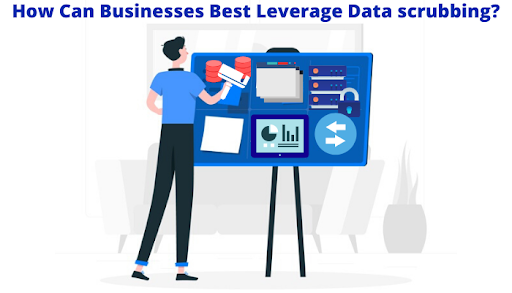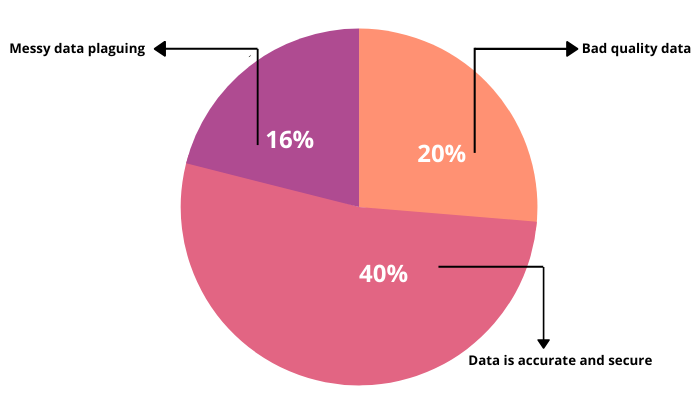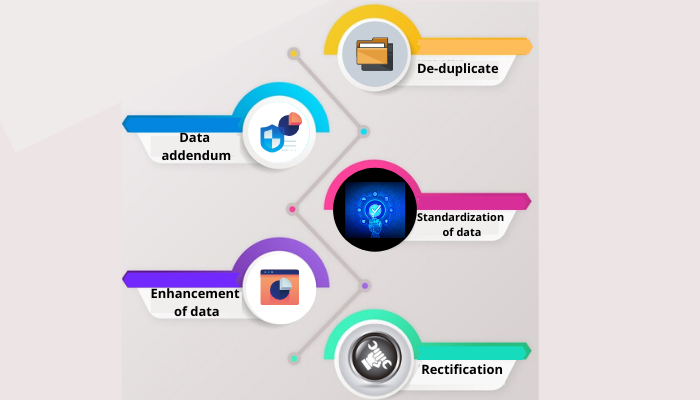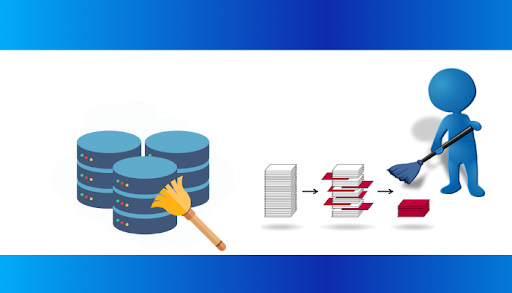The hype around data is hardly news. It is a critical part of a business and rightly so. It is the ultimate competitive differentiator and referred to as the new oil of the world that of course, can’t be used raw and needs to undergo various processes of refinement such as data scrubbing, cleansing and modification.
Poor quality data remains the major challenge, and as per the Data Quality Market Survey, 2017 report by Gartner, poor data costs businesses approximately $15 million yearly. However, it is not a direct financial loss but several indirect and discrete impacts on business processes causing the dent on the business value such as loss in reputation, a higher-risk decision due to poor quality of data and missed opportunities- hitting the businesses where it hurts most! Poor data not only means financial impact but also results in an overall lack of brand value. It is the Achilles’ heel that makes even the massive organisations crumbling down to their knees.
Eighty-four per cent of CEOs are concerned that the data they are basing their decisions on might not be at par. Pitney Bowes in “The Data Differentiator: How Improving Data Quality Improves Business” explains that a company might be basing its decisions on poor data due to the volume of legacy data, silos within departments and difficulty in acquiring buy-ins from the executives. However, we also have companies and innovators like Amazon and Airbnb that are solely operating on the sheer power of good data, which lets them know about their customers, needs, preferences and challenges they face. According to Mei Yang Selvage, Research Director at Gartner, “Organisations operating with bad quality data suffer a financial blow, lose the competition and customers whereas the companies that think of quality data as an enabler and asset not only stay ahead of time but also derive actionable insights from data and generate revenue due to their innovative business model.
As companies are embracing digital transformation with the time, the challenges and bottlenecks around data management are increasing. According to IDC, by 2020, 50 per cent of the Global 2000 will invest and grow in IoT services and products. It also means a data deluge due to the massive cloud, mobile and IoT data. As the companies assess data management infrastructure and want to make the most of big data, it is the mess that the bad data is creating and the most exhausting part they are dealing with! While companies have to deal with CRM data decaying at a rate of more than 30 per cent, little do they know that CRM cleaning and scrubbing can boost their sales, reputation and revenues!
Why do businesses need data scrubbing?
Successful data-driven organisations have a competitive advantage over the messy ones. Poor data is the culprit that doesn’t let businesses reach up to their true potential and reduces them to a dog chasing its tail.
Ø More than twenty per cent of revenue is lost because of bad quality data.
Ø Over forty per cent companies are dealing with messy data plaguing their systems across BI, marketing and CRM and eventually hampering their growth.
Ø Only sixteen per cent of businesses acknowledge that their data is accurate and secure.
When data isn’t clean and is used for Business Intelligence and analytics, it is like mixing Nitrogen and Hydrogen with ignitable liquids. It is just a ticking time bomb waiting to corrode and combust. A business process running on low-quality data puts an entire business at stake. It is a domino effect that results in poor insights and poor results that can be fatal and irreversible for a business.
Neil Patel explains how every organisation has created a mountain of data that is difficult to navigate through. In a rush to achieve this information overload, businesses forget to pay attention to the origin of data.
People change jobs, locations, e-mail IDs, phone numbers and job functions. When the information isn’t synced with the database, it results in bad data. Often businesses utilise a third-party database, which leads to duplication of incorrect data, flooding the system with wrong, outdated and incomplete data.
A lead generation company wastes 546 working hours of a sales rep every year due to bad data.
What is data scrubbing?
Data scrubbing is akin to a system cleanse, a detox that every business is in dire need of and should opt for. It is the most exhaustive and complex part of a business process- like a body system used to junk food resisting to the greens and liquid diet. But it is also very important.
Often confused with data cleaning, it is a process of eliminating incomplete, incorrect, inaccurate, out-of-date, duplicate and inconsistent data.
To keep your data spotless- the backbone of your business- implement Data scrubbing. It ensures stronger campaigns, increased quality leads and competitive advantage for a business along with stronger and more targeted marketing campaigns, enhanced customer satisfaction and higher ROI.
Data scrubbing services include
Data scrubbing services are semi-automated, automated and manual. The data can be customised following a business’ specific need and challenge. The expert and seasoned data engineers work through the vast sets of data in the following phases:
Rectification of records:
An up-to-date customer database is the key priority of data scrubbing. Data scrubbing implement a range of tools, techniques and methods to identify incomplete and inaccurate customer records and take appropriate action. It ensures proper communication with a targeted group of customers.
De-Duplication
When businesses take services of different databases, chances of having similar information run higher. When a sales team sends information, e-mail or unsolicited content, the customers just hit ‘spam’ without giving it a second thought. Data scrubbing utilises the verification and validation techniques to remove duplicate data. De-duplication ensures that only relevant information makes to the database, and the rest of it is flagged out.
Data addendum
When the engineers find out key datasets to be missing, they verify and check the current information and complete the missing record. Digital footprints and offline attributes such as phone number, job, and location are used.
Standardization of data
Several business processes use data in a different format. Some may use a standard title, or some may not. Some may want to categorise the data for specific parameters, whereas, for others, it could be a completely irrelevant criterion. Data scrubbing ensures a uniform pattern of the datasets across the business verticals for easier access and consistency. The entries are similar across the datasets.
Enhancement of data
The data is validated and verified for the information it contains. If needed, the engineers can also assign value to the datasets that can be used to generate insights. The data can be formatted in any format such as Excel, CSV, PDF or XML.
Difference between Data Scrubbing and Data Cleansing
The terms are used interchangeably. However, if you dive deeper into the technicalities:
Data scrubbing is an evolved and more technical process encompassing the merging, translating and filtering out the inconsistencies in data.
Data cleansing is referred to as the identification and elimination of inaccurate and incomplete records in a data set. It also includes the process of deleting and updating the ‘bad’ part of it.
…And that’s about it. Data cleansing and scrubbing go hand-in-hand. This is why it is better to ignore the minute technicalities and tackle the bad data, which is crippling your business.
How does data go bad?
Research by MarketingSherpa found out that up to thirty per cent of data becomes inaccurate. When a business doesn’t work proactively towards to counter the effects of poor-quality data, the growth goes for a toss. It is a disaster waiting to happen. Several factors contribute to bad data, which are:
Legacy Systems: The hype around big data compelled businesses to hoard more and more data. But when it comes to data, less is more. It is the quality that matters. The vast information and databases are difficult to scour through and look for information. Usually, the database is unstructured, incomplete and inaccurate that a business shouldn’t base its insights on.
Silos in Business Processes: A business needs to take along each vertical to propel growth in the right direction. However, siloed data rarely talks, and resultantly, the insights-driven are unidirectional and do not consider each aspect. If your marketing team and sales team are working on noisy and unstructured data without translating the data in a unified format, you aren’t going to like the results.
People: People on either side are responsible for the flow of data. A salesperson entering a lead in the database and making a typo or not following a format is to blame. A customer might have changed his phone number, address or purposely gave out incorrect information. This information, when unverified and entered into the database, leads to a low score data.
Effects of Poor and Bad-Quality Data
Bad data has a domino effect on a business. As per Informatica, seventeen per cent of businesses see data as a valuable asset and integrate it across the channels, whereas only sixteen per cent of business executives are confident of data quality. Poor data costs more than thirty per cent of revenues and still, many businesses are unaware of data efficiency. Dirty data isn’t credible and the end-users often spend more time and money confirming its accuracy, affecting productivity and increasing downtime. It is a manual process and often it is nearly impossible to sift through the vastness of noisy datasets and leading to more inaccuracies. Take United Airlines for example. The American airline’s misplaced trust in its data cost it more than $1 billion loss in revenue as it continued to predict travellers’ preference and airfare prices incorrectly. Bad data prevented them from gathering BI and analytics and identify discrepancies.
- When the CDM or Sales Contact Data Management is inaccurate, it becomes an uphill task for every person and vertical involved in the business. A data scientist spends up to 80 per cent of a day to scrub the data to make it viable for other business processes. A valuable resource doing a janitor’s work isn’t exactly conducive to overall productivity at all. A compromised database can cause end-users productive hours, time and most importantly, a business, its customers!
- An incomplete and duplicate database can also become a PR department’s worst nightmare. If a banking institute doesn’t have updated and verified information of its retail customers, it may end up loaning a huge sum to defaulters, causing a dent in the brand image and perception.
- A company sitting on a pile of unstructured and unverified data may lose out on reading consumers’ mind and expectation, whereas a data-driven business will have a clear competitive advantage.
- Poor and bad-quality data means sending out e-mails to the wrong group, targeting a wrong target group and a sales lead failing to convert into a deal.
Best Data Scrubbing Practices for Businesses
Data scrubbing is complex, but it is an indispensable process. Properly scrubbed data ensures value-driven insights that can drive a business towards its unprecedented growth.
A 2017 report by Forrester established that a Fortune 1000 company could add more than $65 million in revenue to its annual net income with a ten per cent increase in data quality! Who knew bringing in a whopping million is ‘this’ easy and doable!
It is ideal for taking data scrubbing as a journey, a continuous process to keep cleaning it up for the greater good. Good data has always been an elusive goal and organisations need to strive constantly for that. However, it can be managed and monitored regularly to ensure the database in their system remains accurate, consistent, complete and valid. If you want to know how to best leverage data scrubbing, read on!
Data should be standardized.
Data should be standardized and categorized at each entry point. Whether a salutation needs to be followed, the serial numbers, postal codes, filters, location, job title, etc. –each parameter needs to be followed thoroughly. A uniform pattern of data across the vertical helps in setting a process that eventually leads to the sanitation of data. Log all changes, take the backup of both raw and scrubbed data as you make changes and label it.
Align your approach
Believe the experts when they say less is more! You don’t need junk data; you need crucial, concise and domain-specific data that can be useful for your business! Uber’s disruptive God-View Mode isn’t about big data. It is about how smartly they have put their data to use. If your data is accurate, complete and valid, the small data well, maybe, even bigger than the big data! It is time to let go! Don’t sit on the vast dead and obsolete data and instead, start asking the hard-hitting questions:
Do you have a data quality plan?
A data quality plan ensures the integrity and accuracy of data by analysing and finding the root cause of the error. A plan also includes assigning the metrics and setting a contact point in every department to regulate and monitor the quality of data. You should be able to use and read each detail of the data to generate insights out of it. Unless you can do it, there is a scope of improvement.
Tools and Metrics for data accuracy
Does your business implement proper tools and techniques to measure the accuracy of data? If not, it is time to invest in data solutions right now! Alternatively, you can also outsource CRM cleaning and cleansing to a data solution company.
Training and Education.
Change is inevitable, and so does resistance towards it. Rather than pushing your ground and on-field staff to maintain data quality, it is better to educate and train them about the benefits of good-quality data. It is recommended to assign a contact point to help them with any query and question as well as to monitor the quality of data at each entry point.
Your need is specific.
What works for others may not work for you. It is better to assess and analyse why you need to harness the power of data. Hire a CRM cleaning and scrubbing company to discover business-specific insights and data solutions. Knowing the goals and objectives that you want to attain via data will help to figure out the customisations, changes and enhancement.
Validate and Verify.
Data cleaning is just an aspect of good-quality data. Scrubbed data should be enhanced with correct information and verified for accuracy. A quality review should be conducted regularly to discover any anomaly in the system while there is still time.
Data Scrubbing As the Ultimate Solution
According to industry experts, only three per cent of companies meet the basic quality standard of data. Ronald Van Loon in Top 3 Global Machine Learning and Big Data Influencer explains that the data needs to be maintained regularly whereas Big Data Expert Bernard Marr believes that it should be thoroughly cleaned before being used to yield any insights.
This KPMG use case studies Philips and its implementation of three SAP systems that worked to clean up legacy data. It explains how decommissioning the legacy data structure and instilling futuristic technologies ensured a compliant and efficient system for the business. Investment in data scrubbing can lead to better data quality resulting in optimised business processes, efficient system and action-driven insights. Businesses should focus on business-critical data and not “more” data that become an impediment later. Outsource data scrubbing service and reap the full benefits for your business now!








